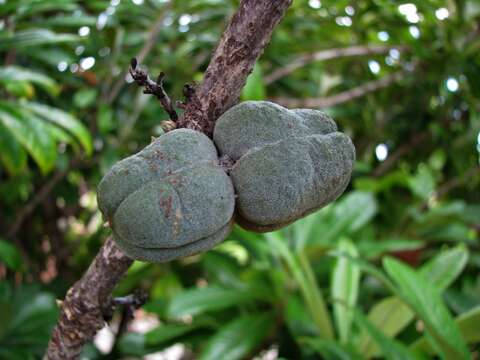Pittosporum hosmeri

Description:
Hawa or Kona cheesewoodPittosporaceae (Pittosporum family)Endemic to the Hawaiian Islands (Kohala Mountains south to the Ka District, Hawaii Island)Oahu (Cultivated)The Hawaiian crow, or alal, (Corvus tropicus) fed on this hawa, attracted by the bright orange inside color of the ripe fruit capsules and dark seeds and thus ensuring the spread of the plants. However, alal are now extremely rare and populations of hawa in the birds former range are becoming very scarce as a result. This is a classic example of how interdependent native Hawaiian plants and animals are in the natural ecosystem.The early Hawaiians used the wood to make gunwales for canoes. The outer layer of the fruit valves were used medicinally. They were pounded and used externally on sores.Flowerswww.flickr.com/photos/dweickhoff/5187804829/in/photolist-...Leaveswww.flickr.com/photos/dweickhoff/8054148306/in/photolist-...Habitwww.flickr.com/photos/dweickhoff/5188406532/in/photolist-...EtymologyThe generic name Pittosporum is derived from the Greek pittos, pitch, and sporos, seed, in reference to the film of viscid resin covering the black seeds.The specific epithet hosmeri is named in honor of Ralph Sheldon Hosmer (1874-1963), Hawaii's first territorial forester. Hosmer's Grove, Maui is one of Hosmer's forestry experimental using non-native species he planted in 1910. Unfortunately, some of the species are now invasive on Maui, such as the Mexican weeping pine, Monterrey pine, and eucalyptus, displacing the native plants.
Included On The Following Pages:
- Life (creatures)
- Cellular (cellular organisms)
- Eukaryota (eukaryotes)
- Archaeplastida (plants)
- Chloroplastida (green plants)
- Streptophyta
- Embryophytes
- Tracheophyta (ferns)
- Spermatophytes (seed plants)
- Angiosperms (Dicotyledons)
- Eudicots
- Superasterids
- Asterids
- Apiales
- Pittosporaceae (cheesewood family)
- Pittosporum (cheesewood)
- Pittosporum hosmeri (Kona cheesewood)
This image is not featured in any collections.
Source Information
- license
- cc-by-nc-sa
- copyright
- David Eickhoff
- photographer
- David Eickhoff
- original
- original media file
- visit source
- partner site
- Flickr Group
- ID


